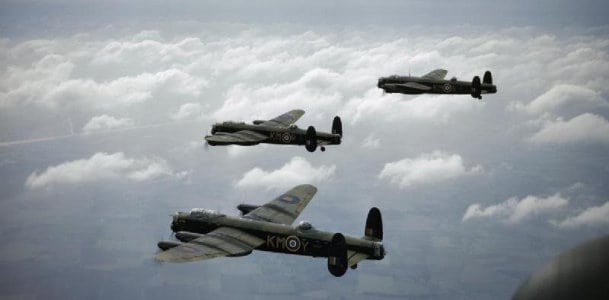I was sitting on a park bench at Dow’s Lake in Ottawa, basking in the late September sun last fall, my bicycle at rest on its kickstand beside me, idly wondering if I should continue reading the book I had brought with me, when I heard a loud roar above and behind me, so loud that I thought at first the approaching aircraft was an Ornge air ambulance helicopter rushing a patient to the Civic Hospital nearby. It wasn’t. It was ‘Vera’ (as in Lynn), bringing with her the unforgettable sound of her four Rolls-Royce Merlin engines, manufactured under license by Packard, powering the iconic Malton-built Avro Lancaster bomber VRA, now seventy years old. She roared past overhead, flown by a civilian Canadian crew, and accompanied by a P-51 Mustang fighter and another aircraft I could not identify. Vera had just flown in from Goose Bay, Labrador after twice crossing the Atlantic to take part in a ‘re-union of giants’ with the only other airworthy Lancaster in the world, ‘Thumper,’ maintained and flown by the Royal Air Force. Vera and Thumper had flown together in a two-month tour of duty throughout the United Kingdom, flying with a Vulcan jet bomber at one point and with the iconic fighter aircraft from Battle of Britain days at another. They gave thousands of appreciative spectators gooseflesh as they flew by. Now Vera was homeward bound to Hamilton, with an overnight stop in Gatineau. The sight of her was an epiphanic moment for me, intensified moments later by the sight of her returning with her escorts on the same flight path, flying directly towards me over Dow’s Lake once more. I got to my feet and waved ecstatically, tears springing to my eyes. After all, she is six years older than me, and deserves my respect.
The moment was made all the more poignant by the knowledge that two days after her passage, I would be going to the funeral for my former colleague Larry Chalk’s dad, an RCAF radio operator who flew in Halifaxes during World War II until he was shot down. His dad was then interned in a Prisoner of War camp, Stalag Luft III, at Sagan in present-day Poland, the site of ‘The Great Escape’ of Paul Brickhill and Steve McQueen fame. Russ Chalk died at 92. My father, a Typhoon pilot who had also been imprisoned in Sagan, had died ten years earlier, aged 83. Too many of their buddies were sadly fated never to have any children, nor grow old beside their wives. They paid for our peace with their lives. This we must never forget.
Seven thousand three hundred and seventy seven Lancasters were built, four hundred and thirty of them at Victory Aircraft, just outside Toronto, between 1943 and 1945. Lancasters were the mainstay of the wartime Bomber Command offensive. Group 6 of Bomber Command was all-Canadian. It operated 13 squadrons of Lancasters from bases in Britain, sent out, night after night, to bomb Nazi Germany into submission, and put an end to Hitler’s inglorious Third Reich, whose only lasting achievement is the death camps at Auschwitz and Treblinka, at Bergen-Belsen, Buchenwald and Ravensbruck, whose survivors have likewise vowed never to forget. The Lancasters droned on through the night to their targets, the industrial cities of the Ruhr, through enemy anti-aircraft fire, enduring the harassing Luftwaffe response, each crew member aware, as they were dazzled by probing searchlights from below, that the chance of completing their mission and crew and bomber returning unscathed could be as low as one in two. My mother, now 93 herself, was a WAAF (Women’s Auxiliary Air Force) sergeant plotter in the ‘Ops’ (Operations) Room at a Lancaster base in Yorkshire, helping direct and map aircraft positions in the air and on the ground. Many times she had seen aircraft fail to return from bombing raids, and remembers the crew members she still calls “the boys” that she knew from the canteen listed as “missing, presumed dead” as the terrible toll mounted.





